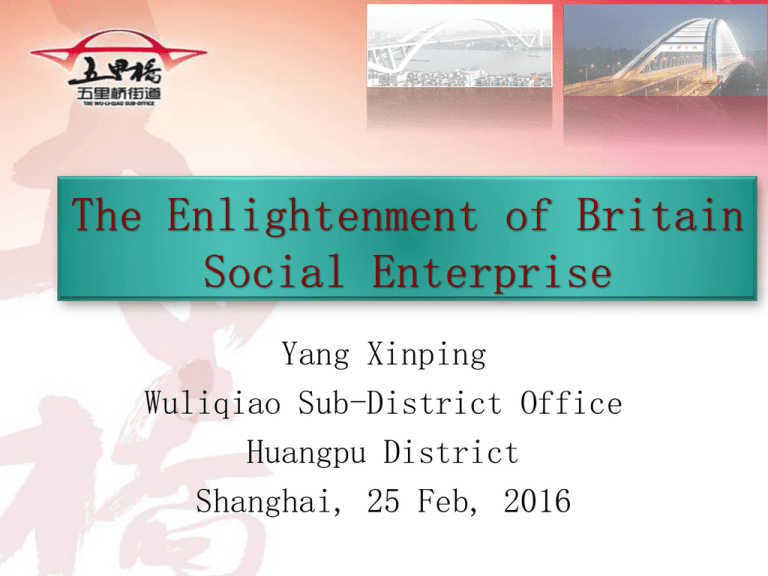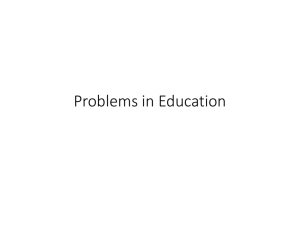Yang Xinping Wuliqiao Sub-District Office Huangpu District Shanghai, 25 Feb, 2016
advertisement

Yang Xinping Wuliqiao Sub-District Office Huangpu District Shanghai, 25 Feb, 2016 First Second • Profile of Social Enterprise (SE) • State of Social Enterprise in UK and China Third • Experience of Social Enterprise in UK Forth • Enlightenment to China UK - the nation being well governed. Smart and successful experience: The mature civil society The advanced government governance The powerful third sector The numerous charity and voluntary and community organizations (VCO) The developed social enterprises (SE), etc. In my opinion, the SE will be booming in the near future in China. •The Profile of First Social Enterprise (SE) The term “social enterprise”having been first coined by Freer Spreckley in 1978 in UK. Bill Drayton, founder of Ashoka, first began using the term “social entrepreneur” in the 1970s. In 2006, Professor Muhammad Yunus of Bangladesh became the first social entrepreneur to receive the Nobel Peace Prize for the Grameen Bank’s efforts to alleviate poverty through microcredit. Concept The definition by the Department of Trade and Industry (DTI) in UK (2002) was generally accepted. Concept “a social enterprise is a business with primarily social objectives whose surpluses are principally reinvested for that purpose in the business or in the community, rather than being driven by the need to maximize profit for shareholders and owners”. Concept Social and environmental objectives of SE % of social enterprise objectives Supporting vulnerable people Improving health and well-being 8% 33% 36% Improving a particular community 65% Creating employment opportunities 36% 65% 45% 64% 48% 59% 60% Addressing social exclusion Supporting other social enterprises and third sector organisations Promoting education and literacy Protecting the environment/fair trade Supporting vulnerable children and young people Addressing financial exclusion Providing affordable housing State of SE in UK The roots of SE reach back to the cooperative movement and the Rochdale Pioneers of 1844. State of SE in UK SE are the important part of the third sector and play a key role in the current Britain society. The Third Sector Social Enterprises Voluntary and Community Organizations Associations Other Organizations Self-help Groups Charity Organizations Community Groups Mutuals Others Goups Cooperatives State of SE in UK Profile of social enterprises in the UK 974 1000 900 800 700 600 500 400 300 200 100 0 475 2005 2012 55 70 Numbers of social enterprises(thousand) Numbers of employees( thousand) State of SE in UK Profile of social enterprises in the UK 54.9 60 50 40 27 18.50 30 20 8.4 10 0 Annual turnover( billions of pounds) Gross value added( billions of pounds) 2005 2012 State of SE in UK over 11 thousand Community Interest Companies (CICs) have been founded up to now. Number of CICs 12000 11040 10000 9177 8000 7670 6000 6392 4905 4000 2653 2000 208 845 3572 1621 0 2005-06 2005-07 2007-08 2008-09 2009-10 2010-11 2011-12 2012-13 2013-14 2014-15 State of SE in UK The breakdown of organizational structures of SEs (%) Categories Company Limited by Guarantee (CLG) 2015 2013 2011 2009 45 51 54 59 Community Interest Company (CIC) 20 17 10 17 Company Limited by Shares (CLS) 16 12 12 7 Industrial and Provident Society (IPS) 9 19 24 37 Sole proprietorship 6 2 Partnership 3 2 Limited Company 1 1 Limited Liability Partnership(LLP) 1 Public Limited Company(PLC) <0.5 1 Other/Don’t know/Not provided 5 11 SE in China The term “social enterprise” is still unfamiliar to most in China. It was first introduced in 2004 The first monograph 《How to Change the World》 was published in 2006. SE in China In 2006, China’s first self-described SE SHOKAY established in Tibet. The 2008 Wenchuan Earthquake in Sichuan caused the flourishing of SEs in China. Characteristics in China A significant proportion of SEs transitioned from NGOs. No clear profit distribution model. Most of SEs do not benefit from taxexemption. Comparison between China’s SEs and UK’s State of SE governance 91% 89% 76% 100% 80% 60% 54% 46% 40% 22% China UK UK 20% China 0% Having formal board of director measuring social impact achieving social objectives Comparison between China’s SEs and UK’s Annual turnover of SE in China and UK 40% 37% 33% 35% 30% 27% 25% 19% 20% 15% 15% 13% 16% 16% 11% 10% 4% 5% 0% 0-10 thousand£ 10-50 thousand£ 50-100 thousand£ 0.1-1 million£ ≥1 million£ China UK Comparison between China’s SEs and UK’s The length of SE in China and UK 60% 50% 40% 51% 31% 30% 35% 29% 20% 10% 19% 14% 6% China UK 15% 0% ≤ 1 year 1-3years 4-5years ≥ 6 years Comparison between China’s SEs and UK’s The resource of primary Start-up funding 77% 80% 70% 60% 50% 44% 38% 40% China UK 30% 20% 11% 10% 16% 8% 0% Government and foundations Loan and finance Family and friends Comparison between China’s SEs and UK’s State of profit of SE in China and UK 50% 50% 45% 40% 35% 30% 25% 20% 15% 10% 5% 0% 42% 33% 26% 25% 20% Made a profit Broke even Made a loss China UK Comparison between China’s SEs and UK’s Age of founders 80% 60% 69% 60% 30% 40% 26% 10% 20% 5% 0% ≤ 44 years old China UK UK China 45-65 years old ≥ 66 years old Comparison between China’s SEs and UK’s Gender of workforce in SE 80% 70% 58%60% 60% 50% 70% 64% 42%40% 36% 30% 40% 30% 20% 10% 0% Female leader Male leader Female employees Male employees China UK Innovative Practices in China Canyou Group – three-in-one developing model with charity foundation, NPO and SE. Canyou Practice in China Development of Canyou Group Year 1999 2015 staff 5 3700 company 1 32 subsidiary companies 1 charity foundation, foundation 0 funding 0 RMB >6 million RMB Board of Director no Formal Society impact no No 1 SE in China Geographic scope 1 community 8 non-profit organizations 11 Provinces Canyou Practice in China Three-in-one operating model Canyou Practice in China China Social Innovation Award Only one China’s Social Enterprise Awarded by Social Enterprise UK Innovative Practices in China Aba Qiang Embroidery (“One Needle One Thread”) Support Program – smart model for “Poverty Alleviation” in remote rural areas. Qiang Embroidery in China Difficulty for the developing and supporting road Qiang Embroidery in China Remote rural women supported by the program Walking to the villages for more than 3 hours Home is the workplace Qiang Embroidery in China The development of Qiang Embroidery Year 2008 2013 staff 10 > 8000 Retail stores Proportion of income from sales Annual turnover 0 10 in 6 cities including Taibei 0 > 90% 0 > 10 million RMB Qiang Embroidery in China Areas supported by the program Qiang Embroidery in China Interaction Relations between main parts participating in Aba Qiang Embroidery Support Program Innovative Practices in China Buy42.com (Shan tao web) – new internet+ mixed model supporting charity and vulnerable people employment. Shantao in China http://www.buy42.com Shantao in China Transparency report showing social impact Shantao in China In 2015, it realized public funds of more than 0.87 million RMB, Sales revenue exceeding 1.29 million RMB, 24,585 public shareholders. •The Experience Third of Social Enterprise (SE) in UK Experience of SE in UK Establishing the specialized administrative agencies. Social Enterprise Unit in 2001, Office of The Regulator of Community Interest Companies in 2004, Office of The Third Sector in 2005, Office for Civil Society in 2010. Experience of SE in UK Publishing the relevant law or criterion to promote the development of SEs. 《Companies (Audit, Investigations and Community Enterprise) Act》 established a new type of companyCommunity Interest Company (CIC) in 2004 Experience of SE in UK 《Public Services(Social Value)Act》 in 2012 required public authorities to have regard to economic, social and environmental well-being which offered more opportunities to the third sector. Experience of SE in UK Introducing the development plan. 《Social Enterprise: A Strategy to Success》 in 2002 《Social Enterprise Action Plan: Scaling New Heights》 in 2006 《Big Society Project》 in 2010 Experience of SE in UK Tax relief policy was dramatically benefit to SE. “Enterprise Investment Scheme” “Community Investment Tax Relief” Experience of SE in UK Mutual help from the mainstream business and other units such as charity and voluntary and community organizations •Enlightenment of Forth Social Enterprise (SE) to China Enlightenment to China foster SE culture clearly put forward the concept for local SE Enlightenment to China Promote the formulation of laws and regulation systems for SEs Improve the accreditation system for SEs. Enlightenment to China Government subsidies and preferential policies More Tax relief similar to UK More funding and procurement opportunities to the third sector organizations Enlightenment to China More Seed funding from public and private foundations Enlightenment to China Universities encourage students to join the social enterprise Adjust the curriculum to meet the need of the market. Enlightenment to China SE should learn from international smart case facilitate cross-sector partnerships with mainstream business system. Partner with other social organizations Enlightenment to China foster a lot of social entrepreneurs in all of social fields in order to meet the demands from SEs in the immediate future.



